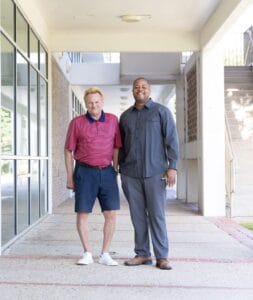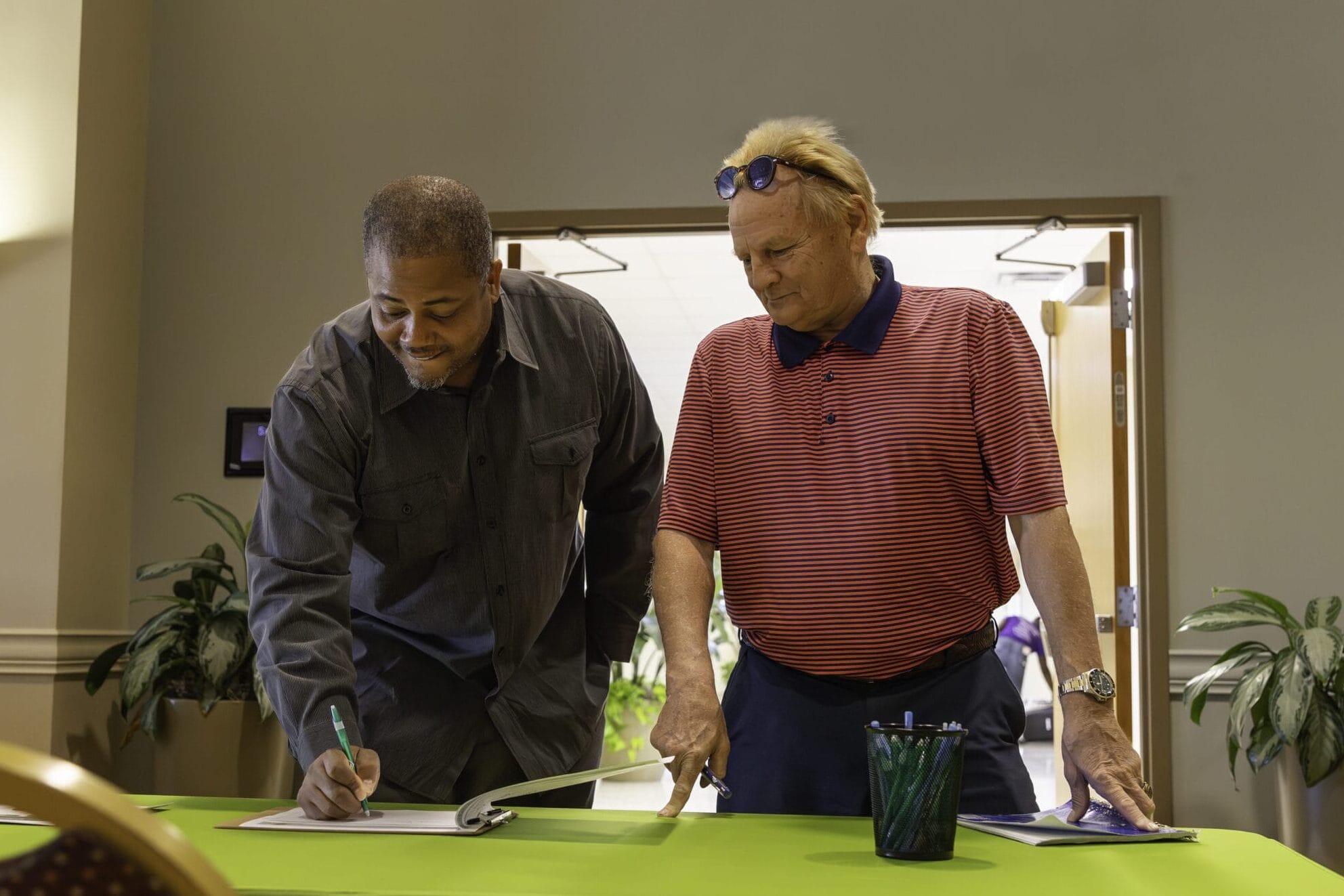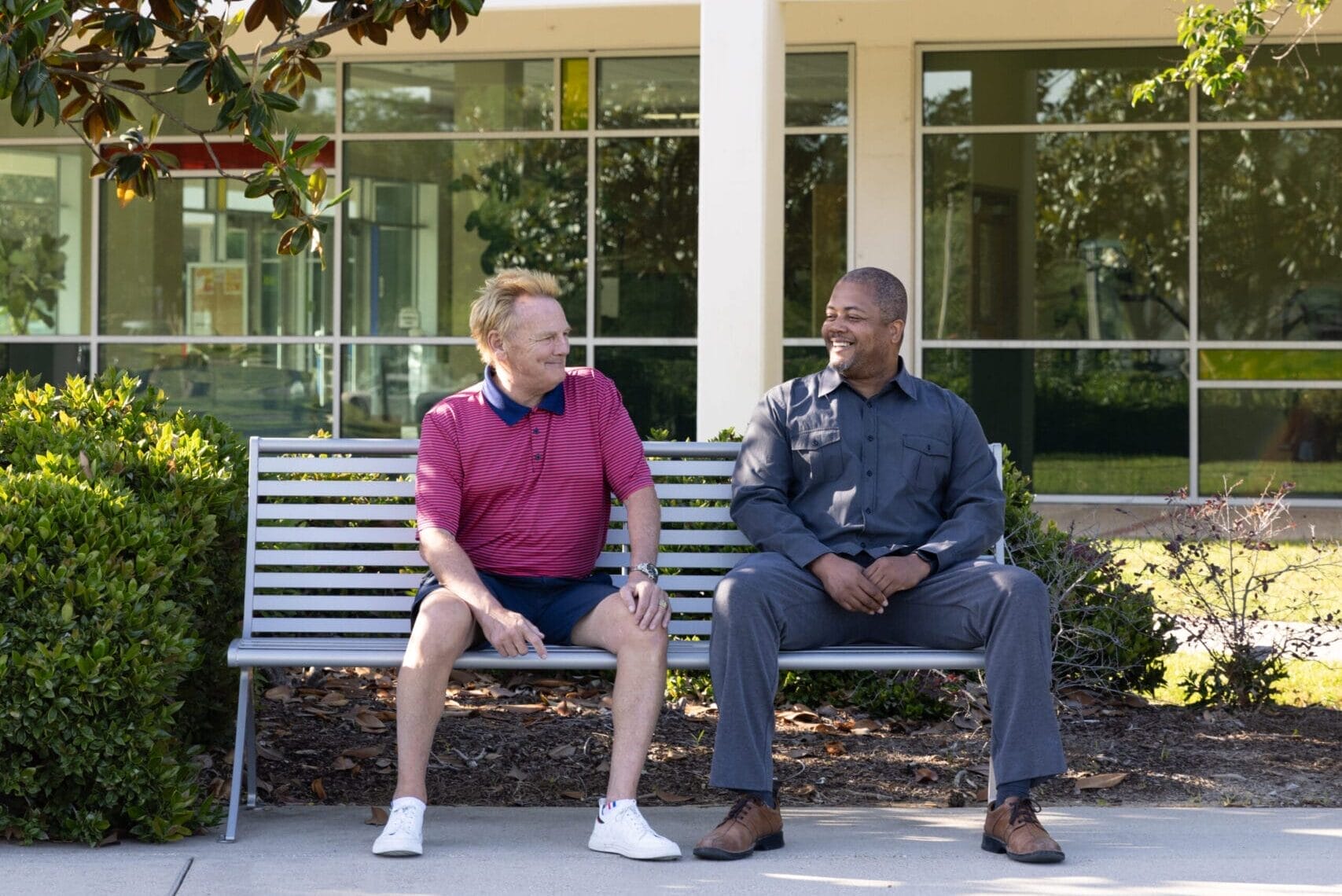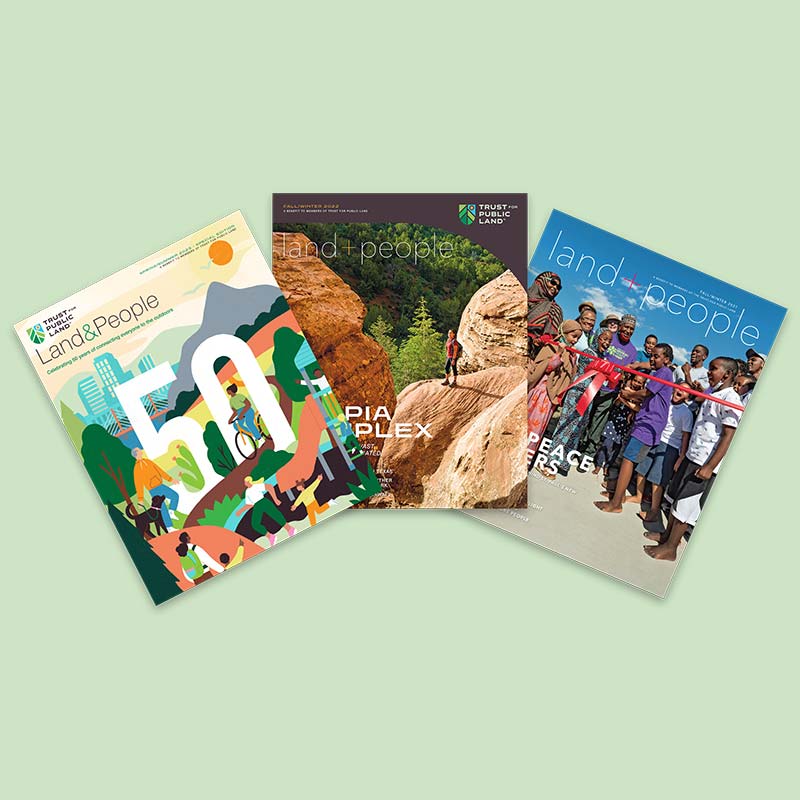When Levar Robinson and Stanley Spring meet each other, it’s with a hug—the kind with tight arms and a long embrace. But a year ago, they were complete strangers.
The two men came together during an effort by the Recreation and Park Commission for the Parish of East Baton Rouge (BREC) to solicit community input for a 10-year systemwide park plan.

Community advisory council members
Stanley Spring (left) and Levar Robinson
outside BREC’s administrative offices. Photo: Jorge Rivas
The park system in East Baton Rouge Parish, Louisiana, has an extraordinarily eclectic list of facilities. It includes everything from your typical neighborhood park to a water park with a surfing simulator and even a velodrome—one of an estimated two dozen cycling arenas still operating in the country.
And then there are golf courses, lakes, a zoo, an equestrian center, and an RV campground spread across the parish. There are 175 parks serving 450,000 people. To inform its next-decade planning effort for all of these sites, the parks department put together its most diverse community advisory group yet.
The project was supported by a community engagement grant from Trust for Public Land, funded by the Walmart Foundation. But TPL also guided park practitioners in tried-and-true community engagement strategies, providing more than six months of training to BREC staff. Similar efforts have been completed at eight other sites nationwide as part of TPL’s On Common Ground program.
In Baton Rouge, the 15-member community advisory council helped BREC shape a plan that was presented to voters ahead of this year’s tax election. The funding assistance from TPL helped BREC compensate community members with $1,000 stipends to supplement time spent away from work and ensure members from low-income neighborhoods were included.
The strategy was a success, with representation that better reflected the population. The department received applications from across the parish, which is made up of 47 percent Black residents, 47 percent white residents, and smaller communities of Latinx, Asian, and Indigenous residents. When it comes to divisions among racial groups, locals say there’s a lot of “history.”
East Baton Rouge Parish desegregated schools under a court order in 1970—16 years after the landmark 1954 Supreme Court Brown v. the Board of Education ruling declared segregated schools to be unconstitutional. It was a divisive time, and remnants of those tensions still exist today.
This park-planning effort aimed to facilitate cooperation despite that history and take steps toward easing those tensions.
Odd Couples, Fast Friends
Under guidance from TPL, leaders from BREC intentionally assigned council members into pairs that cut across lines of difference—paying particular attention to racial and geographic diversity—to maximize interactions between people from different parts of the city and life backgrounds and to build bridges across historic divides.
Each pair of partners was tasked with organizing an “Imagine Your Parks” event at a local BREC facility to collect feedback from residents on the 10-year plan. In addition to helping formulate the surveys, they worked to spread the word about the effort.
In the end, lasting friendships have flourished between council members—people like Levar Robinson and Stanley Spring—who say they wouldn’t have crossed paths outside of this process.

Community advisory council members Levar Robinson (left) and Stanley Spring collaborate on a park event for the Recreation and Park Commission for the Parish of East Baton Rouge. Photo: Jorge Rivas
“I didn’t expect Stanley and I to click,” Robinson, 46, told a room full of colleagues as he affectionately pointed to his council partner. The room erupted in laughter when Robinson made this declaration.
“I think they laughed because they identified with what Levar said,” Spring, 72, explains, referring to the nervous tension of working with someone who comes from another part of the parish—someone with a different cultural background and lived experience. “I had reservations when I first met Levar,” says Spring, but in the first five minutes, they hit it off. “It was just like that,” he says as he snaps his fingers.
Robinson is the founder and CEO of Fathers on a Mission, a local nonprofit community organization; he’s a Black man who was born and raised on the north side of Baton Rouge, the historically Black, working-class side of town, which he describes as underserved. Spring is white and a retired litigator from the south side of Baton Rouge, the more affluent and white part of town.
“I looked around at all the different people, and I was really nervous about it, but when I got to know them and got that mutual understanding, we got rid of that polarization.”
– Stanley Spring, community advisory council member
Says Robinson, “Even as a grown man, because of past experiences and trauma, you don’t necessarily know what’s going to be the outcome of [collaborating with] someone new.” He found himself questioning if Spring would accept him and his opinions: “Is he going to be okay with what I feel, how I think?” Robinson asked himself. But that quickly changed once they spent a little time together.
Spring was asking himself the same questions. “I looked around at all the different people, and I was really nervous about it, but when I got to know them and got that mutual understanding, we got rid of that polarization,” he notes.
Spring acknowledges that if it wasn’t for parks, he and Robinson would never have met. Robinson agrees. But due to this experience, they’ve exchanged numbers and keep in touch. “When you intentionally invest in parks programs to bring people together, bonds form,” says Cary Simmons, who leads the On Common Ground program as TPL’s director of community strategies.
The experience had a positive impact on staff, as well: “I learned more in the first five months of working with my community advisory council about different communities and areas in this parish than I have in my 18 years working in recreation,” says Katrina Coots Ward, BREC’s partnership and development director, “because you really have to engage with the community.”
“I learned more in the first five months of working with my community advisory council . . . than I have in my 18 years working in recreation.”
– Katrina Coots Ward, BREC’s partnership and development director
Robinson and Spring co-organized their event at a BREC golf course. About 60 people—parents and children—attended on a cold Sunday in January. Parents filled out surveys while their children enjoyed free snacks and competed to win cash prizes.
Children and teens were split into age groups and each given a putter and five golf balls; whoever got closest to the hole won a prize. Spring says he was happy with the turnout, especially considering the weather.
Now, Spring and Robinson say they will continue collaborating. Spring recently applied to join the board of directors at Fathers on a Mission, which offers resources to help fathers become positive roles models for their loved ones and in their communities. Spring and Robinson, who both have children, hope to develop a program that uses golf to get dads and sons together to build stronger relationships.
Donate today and help us connect more people to nature and each other.
Parks with Purpose
Trust for Public Land’s Common Ground Framework, a first-of-its-kind resource, proves with academic rigor that parks can and do bring people together. Employing community advisory councils is one of more than 50 engagement strategies that TPL includes in the framework, which guided their efforts in East Baton Rouge Parish and the other pilot sites. It asserts that green spaces are inherently inclusive places that foster belonging, and that the shared experience of engaging in park planning strengthens social ties and creates connections among residents. What TPL’s work with BREC has proved is that if you invest in programming and planning to bring people together around parks, you develop camaraderie.

Community advisory council members
Stanley Spring (left) and Levar Robinson
outside BREC’s administrative offices. Photo: Jorge Rivas
“It doesn’t surprise me at all because parks are natural settings for community building,” says Simmons. The interactions fostered in parks enable people to express their unique identities, offering neighbors a fresh perspective on their community through a different and new lens, he explains.
Even though these bonds can happen organically—for example, residents of Baton Rouge might spark conversations and discover mutual interests while waiting to ride the waves at the surfing simulator or renting a kayak at the swamp—parks departments can also cultivate meaningful exchanges between locals through intentional programming.
“The human connection we have with our parks and public spaces is one of the things that just continues to bond us all universally.”
– Cary Simmons, TPL director of community strategies
Once participants make that connection, there’s a ripple effect that continues to spread. Levar Robinson and Stanley Spring, for example, started collaborating around parks and now will continue working together to address concerns that go beyond green spaces.
In a country that is so often described as divided, parks have the potential to be neutral and welcoming spaces where people can come together. That’s why Simmons says he hopes other communities will look to the success of BREC and follow suit.
“The human connection we have with our parks and public spaces is one of the things that just continues to bond us all universally,” says Simmons. And he’s not just touting an idealistic theory. Thanks to the efforts of TPL and partners, the proof is in the parks—and the people they bring together.
Jorge Rivas is a firm believer in the power of storytelling and visual communications to inform and move people into action. He has been recognized with a GLAAD Media Award and medals from the National Association of Hispanic Journalists for his investigative reporting.

Donate to become a member, and you’ll receive a subscription to Land&People magazine, our biannual publication featuring exclusive, inspiring stories about our work connecting everyone to the outdoors.
